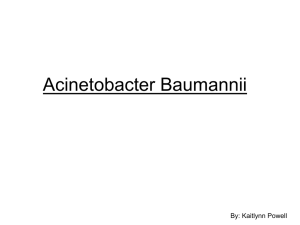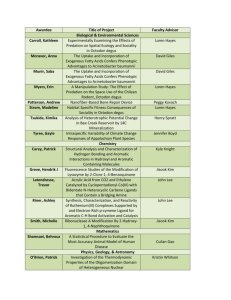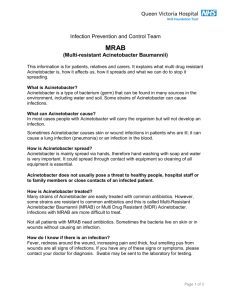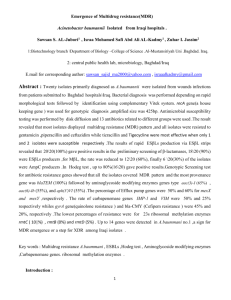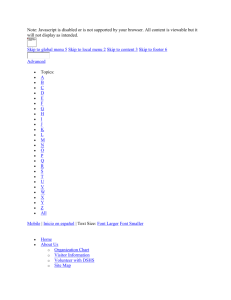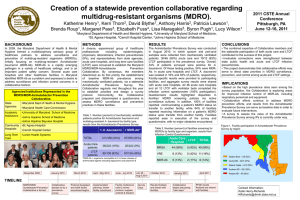A bstract
advertisement
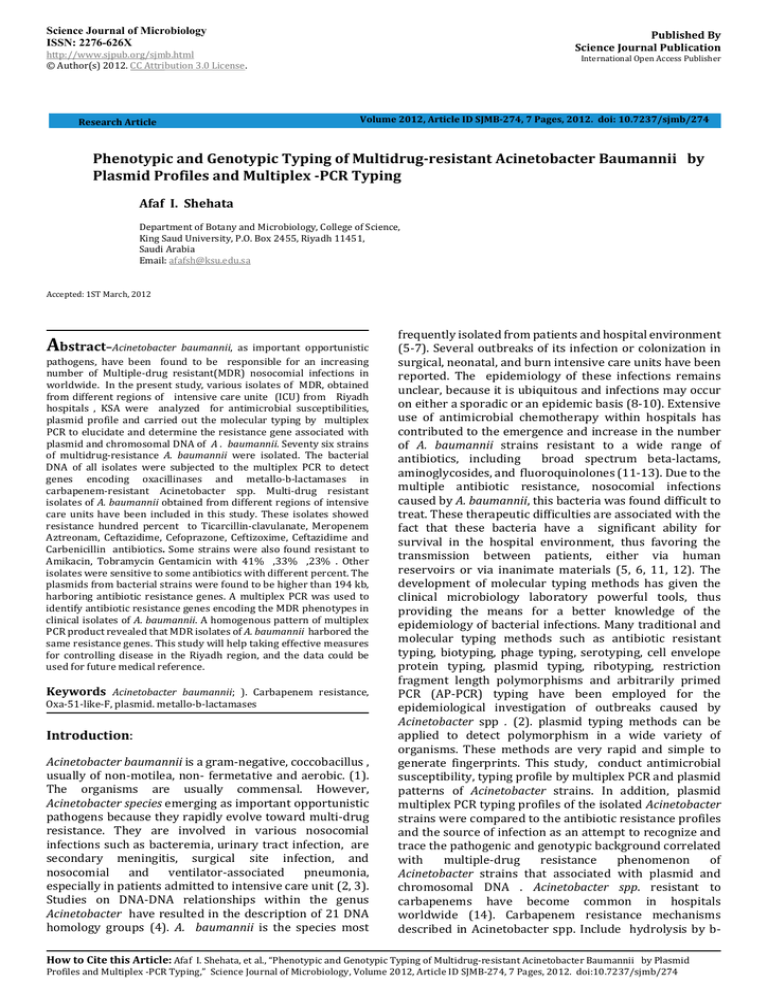
Science Journal of Microbiology ISSN: 2276-626X Published By Science Journal Publication http://www.sjpub.org/sjmb.html © Author(s) 2012. CC Attribution 3.0 License. Research Article International Open Access Publisher Volume 2012, Article ID SJMB-274, 7 Pages, 2012. doi: 10.7237/sjmb/274 Phenotypic and Genotypic Typing of Multidrug-resistant Acinetobacter Baumannii by Plasmid Profiles and Multiplex -PCR Typing Afaf I. Shehata Department of Botany and Microbiology, College of Science, King Saud University, P.O. Box 2455, Riyadh 11451, Saudi Arabia Email: afafsh@ksu.edu.sa Accepted: 1ST March, 2012 Abstract–Acinetobacter baumannii, as important opportunistic pathogens, have been found to be responsible for an increasing number of Multiple-drug resistant(MDR) nosocomial infections in worldwide. In the present study, various isolates of MDR, obtained from different regions of intensive care unite (ICU) from Riyadh hospitals , KSA were analyzed for antimicrobial susceptibilities, plasmid profile and carried out the molecular typing by multiplex PCR to elucidate and determine the resistance gene associated with plasmid and chromosomal DNA of A . baumannii. Seventy six strains of multidrug-resistance A. baumannii were isolated. The bacterial DNA of all isolates were subjected to the multiplex PCR to detect genes encoding oxacillinases and metallo-b-lactamases in carbapenem-resistant Acinetobacter spp. Multi-drug resistant isolates of A. baumannii obtained from different regions of intensive care units have been included in this study. These isolates showed resistance hundred percent to Ticarcillin-clavulanate, Meropenem Aztreonam, Ceftazidime, Cefoprazone, Ceftizoxime, Ceftazidime and Carbenicillin antibiotics. Some strains were also found resistant to Amikacin, Tobramycin Gentamicin with 41% ,33% ,23% . Other isolates were sensitive to some antibiotics with different percent. The plasmids from bacterial strains were found to be higher than 194 kb, harboring antibiotic resistance genes. A multiplex PCR was used to identify antibiotic resistance genes encoding the MDR phenotypes in clinical isolates of A. baumannii. A homogenous pattern of multiplex PCR product revealed that MDR isolates of A. baumannii harbored the same resistance genes. This study will help taking effective measures for controlling disease in the Riyadh region, and the data could be used for future medical reference. Keywords Acinetobacter baumannii; ). Carbapenem resistance, Oxa-51-like-F, plasmid. metallo-b-lactamases Introduction: Acinetobacter baumannii is a gram-negative, coccobacillus , usually of non-motilea, non- fermetative and aerobic. (1). The organisms are usually commensal. However, Acinetobacter species emerging as important opportunistic pathogens because they rapidly evolve toward multi-drug resistance. They are involved in various nosocomial infections such as bacteremia, urinary tract infection, are secondary meningitis, surgical site infection, and nosocomial and ventilator-associated pneumonia, especially in patients admitted to intensive care unit (2, 3). Studies on DNA-DNA relationships within the genus Acinetobacter have resulted in the description of 21 DNA homology groups (4). A. baumannii is the species most frequently isolated from patients and hospital environment (5-7). Several outbreaks of its infection or colonization in surgical, neonatal, and burn intensive care units have been reported. The epidemiology of these infections remains unclear, because it is ubiquitous and infections may occur on either a sporadic or an epidemic basis (8-10). Extensive use of antimicrobial chemotherapy within hospitals has contributed to the emergence and increase in the number of A. baumannii strains resistant to a wide range of antibiotics, including broad spectrum beta-lactams, aminoglycosides, and fluoroquinolones (11-13). Due to the multiple antibiotic resistance, nosocomial infections caused by A. baumannii, this bacteria was found difficult to treat. These therapeutic difficulties are associated with the fact that these bacteria have a significant ability for survival in the hospital environment, thus favoring the transmission between patients, either via human reservoirs or via inanimate materials (5, 6, 11, 12). The development of molecular typing methods has given the clinical microbiology laboratory powerful tools, thus providing the means for a better knowledge of the epidemiology of bacterial infections. Many traditional and molecular typing methods such as antibiotic resistant typing, biotyping, phage typing, serotyping, cell envelope protein typing, plasmid typing, ribotyping, restriction fragment length polymorphisms and arbitrarily primed PCR (AP-PCR) typing have been employed for the epidemiological investigation of outbreaks caused by Acinetobacter spp . (2). plasmid typing methods can be applied to detect polymorphism in a wide variety of organisms. These methods are very rapid and simple to generate fingerprints. This study, conduct antimicrobial susceptibility, typing profile by multiplex PCR and plasmid patterns of Acinetobacter strains. In addition, plasmid multiplex PCR typing profiles of the isolated Acinetobacter strains were compared to the antibiotic resistance profiles and the source of infection as an attempt to recognize and trace the pathogenic and genotypic background correlated with multiple-drug resistance phenomenon of Acinetobacter strains that associated with plasmid and chromosomal DNA . Acinetobacter spp. resistant to carbapenems have become common in hospitals worldwide (14). Carbapenem resistance mechanisms described in Acinetobacter spp. Include hydrolysis by b- How to Cite this Article: Afaf I. Shehata, et al., “Phenotypic and Genotypic Typing of Multidrug-resistant Acinetobacter Baumannii by Plasmid Profiles and Multiplex -PCR Typing,” Science Journal of Microbiology, Volume 2012, Article ID SJMB-274, 7 Pages, 2012. doi:10.7237/sjmb/274 Science Journal of Microbiology ISSN: 2276-626X lactamases, alterations in outer-membrane proteins and penicillin binding proteins, and increased activity of efflux pumps (15). However, carbapenemases, such as metalloblactamase (MBL) or oxacillinases, cause the most concern due to the chance of rapid dissemination (16,17,18)). Four families of oxacillinases have been described in Acinetobacter baumannii so far: OXA-23- like, OXA-24-like and OXA-58-like enzymes, and OXA-51-like, a chromosomal oxacillinase enzyme present in A. baumannii that when over expressed can be associated with carbapenem resistance (19, 17). The aim of the present study was therefore to conduct a multiplex PCR assay for detecting genes encoding oxacillinases and MBL to evaluate the presence of carbapenemase genes among nosocomial carbapenem-resistant Acinetobacter spp. Materials and Methods Bacterial isolates A. baumannii was isolated from hospitalized patients depending of age, sex, race, underlying illness. Was obtained by chart review based on Centers for Disease Control guidelines (20). All A. baumannii isolates were collected from the clinical microbiology laboratory and stored at -70°C in brucella broth containing 20% glycerol.. A total of One hundred and eighteen Acinetobacter spp. isolates were obtained .The location of infections included was blood, urine, wound, and respiratory tract (Table 1). The specimens were cultured on blood agar and McConkey agar. Isolates were identified as members of the genus Acinetobacter by Gram negative, coccoid, oxidase negative, non-motile, and non-fermenting bacteria. They were identified as A. baumannii by the simplified identification scheme including growth at 37°C, 41°C, 44°C; production of acid from glucose under oxidative condition; gelatin hydrolysis; and assimilation of different carbon sources (21)clinical isolates of A. baumannii were collected and used for this study Antimicrobial susceptibility: Antimicrobial susceptibility testing using Twelve antibiotics were determined by the agar disk diffusion method (Kirby-Bauer) (22, 23). The following antimicrobial agents (Manta Medicinal Chemicals and Botanical Products USA) at the indicated concentrations were tested: Ticarcillinclavulanat(Tc45/5μg),Meropenem(Mr10μg), Aztreonam(Ao30 μg) ceftazidime (Ca 30 μg), cefoprazone (Cs 65 μg), ceftizoxime (Ck 35 μg), carbenicillin (Cb 15 μg) amikacin (Ak 30 μg), tobramycin (Tb 10 μg),Gentamicin(Gn30 μg) Polymixin B(Pb 120 μg),Colistin (C 100 μg ).(Table 2).. Page 2 chloroform/isoamylalcohol was added to mixture and centrifuged at 10,000 rpm for 10 min. The supernatant was added to an equal volume of chloroform and after centrifuging at 10000 rpm , the top layer was collected and DNA was precipitated with two volumes of cold isopropanol at -20° C for 10 min. The pellet was obtained by centrifugation for 20 min and washed with 1.5 ml of 70% cold ethanol. Finally the pellet was resuspended in 100 ml of TE 1X buffer (10 mM Tris-Cl,1 mM Na2 EDTA, pH 8) Extraction of plasmid: A colony of A. baumannii was inoculated in 5 ml of LB broth and incubated overnight at 37°C in shaking water bath. The cells were centrifuged at 5000 rpm at room temperature for 10 minutes. Plasmids were then extracted by the alkaline lysis method (24 ) Plasmid DNA was extracted using a commercial plasmid extraction kit (Plasmid Midi Kit, Qiagen). Plasmid analysis and endonuclease mapping: Approximately 7 μl of the plasmid DNA was loaded to 1% agarose gel in TAE buffer system with Escherichia coli NCTC 50193 (CECT 678R) standard plasmid DNA as a molecular weight marker. The electrophorised gel was stained with ethidium bromide (1.5 μg/ml) and analyzed on a Bio‐Rad Geldoc-2000 gel-documentation system equipped with a Quantity 01 Software (Bio-Rad Laboratories, Richmond, California). About 1 µg of plasmid DNA was used for digestions with restriction enzymes EcoRI, and HindIII endonucleases (invitrogen) following the indications of the manufacturer. Multiplex PCR reaction conditions Both multiplex PCRs were performed at the same time with seven pairs of specific primers, one pair for each of the seven gene families (Table 3). The DNA template was obtained at the concentration of 20 ngµl-1. using a genomic Prep cell and tissue DNA isolation kit (Amersham Pharmacia Biotech). The PCR mixture used was as follows: 1 ml DNA template in a 49 ml mixture containing 10 mM Tris/HCl (pH 8.8), 4 mM MgCl2, 50 mM KCl, 0.1% Triton X-100, 200 mM each dNTP, 30 n M oxacillinase primers, 200 nM IMP primers, 100 nM VIM primers, 50 nM SIM primers and 1 U Taq DNA polymerase. The PCR conditions were as follows: initial denaturation at 94 uC for 5 min, 33 cycles of 94°C for 25 s, 53°Cfor 40 s and 72° C for 50 s, followed by a single, final, elongation step at 72 uC for 6 min. Results: DNA extraction Antimicrobial susceptibility: Bacterial strains were cultured aerobically in LB broth at 37° C. Two ml of overnight culture was centrifuged at 4,000 rmp for 20 min. The pellet was resuspended in 620 ml of lysis buffer (10 mM Tris-HCl, 50 mM EDTA, 100 mM NaCl, pH 8) containing 1% SDS and 0.4 mg/ml of proteinase K. The mixture was incubated for 1 h at 56° C and then at 100° C for 1 h. Then, an equal volume of phenol/ A total of 118 Acinetobacter spp. isolates including 76 A. baumannii and 42 non-A. baumannii strains. Table 1 shows distribution of the isolates in terms of the sample sources. The strains were frequently isolated from urine samples ( 55%) , 21, 15.8 ,8 from Respiratory tract, blood and wound respectively. Analysis of twelve antibiotic were tested. Resistance patterns showed that All Acinetobacter spp. How to Cite this Article: Afaf I. Shehata, et al., “Phenotypic and Genotypic Typing of Multidrug-resistant Acinetobacter Baumannii by Plasmid Profiles and Multiplex -PCR Typing,” Science Journal of Microbiology, Volume 2012, Article ID SJMB-274, 7 Pages, 2012. doi:10.7237/sjmb/274 Page 3 Science Journal of Microbiology ISSN: 2276-626X were multi-drug resistant (100%). As shown in Table 2, all A. baumannii isolates were resistant to at least seven antibiotic. A. baumannii isolates that were resistant to Ticarcillin-clavulanate, Meropenem Aztreonam, Ceftazidime, Cefoprazone, Ceftizoxime and Carbenicillin antibiotics but susceptible to Colistin (42% ) ,Carbenicillin(21% ), Polymixin B(13% ), Tobramycin(9% ), Amikacin( 6% ),and Gentamicin( 2% ) that compared to Non- A. baumannii isolates. multiple mechanisms of resistance leads to the development of multiply resistant or even “panresistant” strains. (33)Identical size plasmids were observed in isolates obtained, indicating that they were stably inherited in the population. The predominant location of the blaOXA40 gene was large kb plasmid(34).Carbapenems are very useful for the treatment of infections caused by Gram – negative bacilli that are resistant to other β‐lactam antibiotics. Plasmid analysis : However, Carbapenems – resistant Gram - negative bacilli are being isolated sources. Acinetobacter producing IMPtype metallo‐ β‐lactamases and its other such as VIM‐1 and VIM-2 that detected in Acinetobacter pp(35).Multiple drugresistant strains of Acinetobacter have created therapeutic problem worldwide. This study was conducted to determine the antimicrobial susceptibility patterns and prevalence of blaOXA-type Carbapenemases among isolates of Acinetobacter. Here 55%of Acinetobacter isolates were identified with their susceptibility to multiplex PCR targeting blaOXA genes . More than 5o% of the isolates showed multidrug resistance to different antibiotics. The rate of susceptibility to imipenem Ticarcillin-clavulanate, Meropenem Aztreonam, Ceftazidime, Cefoprazone, Ceftizoxime and Carbenicillin antibiotics but susceptible to Colistin (42% ) ,Carbenicillin(21% ), Polymixin B(13% ), Tobramycin(9% ), Amed a ikacin( 6% ),and Gentamicin( 2% ) that compared to Non- A. baumannii isolates.All isolates of Acinetobacter baumannii possess blaOXA-51-like genes.The CO- existence of blaOXA-51-like/ blaOXA-23like and blaOXA-51-like/ blaOXA-24-like was detected in the isolates. Resistance to Carbapenems is high, with the majority of isolates showing multi resistance. A wide diversity of oxa genes exist among the isolates of antibiotics . Detection of blaOXA-51-like can be used as simple and reliable methods to differentiate Acinetobacter baumannii Three different groups of A. baumannii isolates A were identified on the basis of antibiotic sensitivity pattern (Table 1). Representatives from each group were selected for plasmid analysis; and detection of restriction analysis profile . The analysis of plasmid in MDR isolates revealed the presence of plasmid with an approximate molecular weight over 194 k bp. almost for all the isolates. (Fig. 1). Molecular analysis of antimicrobial resistance gene in MDR A. baumannii isolates using multiplex PCR: Detection of genes encoding oxacillinases and MBLs in carbapenem-resistant Acinetobacter spp. by multiplex PCR All clinical isolates showed positively for blaOXA-51-like genes. (38 %) of these isolates had blaOXA-23-like genes and four (9 %) had the gene blaIMP (Fig. 3). The imipenem MIC among blaOXA-23-like positive strains ranged from 16 to 128 µg m1-1 and was lower compared with IMP-1 positive strains. The present study showed that all strains had blaOXA-51-like genes and 38% had blaOXA-23-like genes. Discussion: Acinetobacter baumannii is an opportunistic pathogen that may be an important threat due to its increasing multidrug resistance in nosocomial isolates, mostly from intensive care units (25). A. baumannii naturally produces a chromosomally encoded AmpC-type enzyme which is responsible for resistance to amino- and ureidopenicillins and narrow-spectrum cephalosporins and cephamycins and that may be overproduced(26, 27, 28). The oxacillinhydrolyzing _-lactamases (oxacillinases) belong to class D of the _-lactamases (29). They usually hydrolyze oxacillin, methicillin, and cloxacillin better than benzylpenicillin, and their activity is inhibited by NaCl (29). Where as most of the oxacillinases are plasmid mediated, several natural and chromosomally encoded oxacillinases have been reported in several environmental species (27, 30 ,31) and also in clinically relevant gram-negative species, such as A. baumannii.(32).Acinetobacter species are noted for their intrinsic resistance to antibiotics and for their ability to acquire genes encoding resistance determinants. Foremost among the mechanisms of resistance in this pathogens is the production of β‐lactamases and aminoglycoside‐ modifying enzymes. Additionally, diminished expression of outer membrane proteins, mutations in topoisomerases, and up-regulation of efflux pumps play an important part in antibiotic resistance. Unfortunately, the accumulation of Table1. Distribution of the isolates by sample site. Isolates Acinetobacter spp Number (%) Non- A. bauA. baumannii mannii Num(%) ber (%) Source Blood 16 (21) urine 42 (55) Wound Respiratory tract Total 6 (14.3) 17 (40.5) 10 (23.8) 6 22 (8.6) 59 (50) 16(14.5) (8) 12 (15.8) 9 (21.4) 21(17.8) 76 42 118(100) How to Cite this Article: Afaf I. Shehata, et al., “Phenotypic and Genotypic Typing of Multidrug-resistant Acinetobacter Baumannii by Plasmid Profiles and Multiplex -PCR Typing,” Science Journal of Microbiology, Volume 2012, Article ID SJMB-274, 7 Pages, 2012. doi:10.7237/sjmb/274 Science Journal of Microbiology ISSN: 2276-626X Page 4 Table 2. Antimicrobial susceptibility of 118 Acinetobacter spp. strains. (Zone of inhibitions for different antibiotics by Kirby Bauer Disk diffusion) Acinetobacter spp. A. baumannii isolates S R Number % I Number % Number % Antibiotic Non- A. baumannii isolates R Number % I Number % S Number % 11(26.1) 1(2.4) 10(23.8) 7(16.7) Ticarcillinclavulanate 76(100) 0 0 Meropenem 76(100) 0 0 Aztreonam 76(100) 0 0 32(76.1) 0 Ceftazidime 76(100) 0 0 40(95.2) Cefoprazone 76(100) 0 0 29(69) 0 7(16.7) 76(100) 0 0 Carbenicillin 76(100) 0 0 Amikacin 41(54) 0 35(46) Tobramycin 33(43.4) 4(5.3) 39(51.3) Gentamicin 23(30.2) 0 53(69.7) Polymixin B 0 23(30.3) 53(69.7) Ceftizoxime 30(71) 25(59.5) 34(80.9) 10(23.8) 2(4.7) 6(14.3) 0 8(19) 11(26.2) 21(50) 0 6(14.3) 5(11.9) 9(21.4) 0 2(4.76) 2(4.76) 13 0 42(100) 36(85.7) 28(66.7) 40(95.2) 27(64.2) Colistin 0 0 76(100) R: resistant, I: intermediate, S: sensitive. 10 (23.8) 0 Table 3. Sequences of primers used for multiplex PCR for detection of genes encoding MBLs and oxacillinases in isolates of Acinetobacter spp. Primer Imp-F Imp-R mp-F Imp-R mp-F Imp-R Oxa-51-like-F Oxa-51-like-R Oxa-23-like-F Oxa-23-like-R Oxa-24-like-F Oxa-24-like-R Oxa-58-like-F Oxa-58-like-R Sequence Length (bp) 5-GAATAGAATGGTTAACTCTC-3' 188 5-CCAAACCACTAGGTTATC-3' 5-GTTTGGTCGCATATCGCAAC-3' 5-AATGCGCAGCACCAGGATAG-3' 5-GTACAAGGGATTCGGCATCG-3' 5-GTACAAGGGATTCGGCATCG-3' 382 5-TAATGCTTTGATCGGCCTTG-3' 353 569 5-TGGATTGCACTTCATCTTGG-3' 5-GATCGGATTGGAGAACCAGA-3' 501 5-ATTTCTGACCGCATTTCCAT-3' 5-GGTTAGTTGGCCCCCTTAAA-3' 246 5-AGTTGAGCGAAAAGGGGATT-3' 5-AAGTATTGGGGCTTGTGCTG-3' 599 5-CCCCTCTGCGCTCTACATAC-3' How to Cite this Article: Afaf I. Shehata, et al., “Phenotypic and Genotypic Typing of Multidrug-resistant Acinetobacter Baumannii by Plasmid Profiles and Multiplex -PCR Typing,” Science Journal of Microbiology, Volume 2012, Article ID SJMB-274, 7 Pages, 2012. doi:10.7237/sjmb/274 Page 5 Science Journal of Microbiology ISSN: 2276-626X A 1 2 3 4 5 6 7 8 9 10 11 12 13 Kb 194 97 48.5 Fig. 1. Plasmids of Acinetobacter baumannii( MDR) Lane A (low molecular size weight , standerd marker ); lane 1,2 ,5 and 10 antibiotic sensitive Acinetobacter baumannii; lane 4,6-9,11,12,13 MDR A. baumannii isolates M 1 2 3 4 5 6 7 8 9 10 11 M 200 97 Figure . 2 Different plasmid profiles obtained in the A . baumannii isolates. Lane 1, marker (M). Line1-11 represent restriction analysis of isolated Plasmid with EcoRI, and HindIII restriction enzymes How to Cite this Article: Afaf I. Shehata, et al., “Phenotypic and Genotypic Typing of Multidrug-resistant Acinetobacter Baumannii by Plasmid Profiles and Multiplex -PCR Typing,” Science Journal of Microbiology, Volume 2012, Article ID SJMB-274, 7 Pages, 2012. doi:10.7237/sjmb/274 Science Journal of Microbiology ISSN: 2276-626X M 1 2 3 Page 6 4 5 6 7 8 9 10 11 M Figure 3. Detection of genes encoding oxacillinases and MBLs in carbapenem-resistant Acinetobacter spp. by multiplex PCR. Lane 9 negative control; lane 1, blaOXA-51 and blaSIM-like gene lane 2 blaOXA-24-like gene and blaOXA-51 - like gene; lane 3, blaVIM -like gene; lane 4, blaIMP and blaSIM like gene; lane 5, blaOXA-51 and blaSIM -like gene; lane 6, blaOXA-51 and blaSIM -like gene; lanes 7, blaOXA-51 and blaSIM -like gene lane8, blaOXA-24and blaOXA-51 - like gene ,10 isolates carrying blaOXA-51-like gene; lanes 10, blaVIM -like gene. 9 isolates carrying blaOXA-23-like gene; lane 11, blaOXA-24and blaOXA-51 - like gene. M, Molecular mass markers (100 bp DNA ladder). References 1. 2. 3. 4. 5. Lautenbach E, Synnestvedt M, Weiner MG, Bilker WB,Vo L, Schein J, et al. Epidemiology and impact of imipenem resistance in Acinetobacter baumannii. Infect Control Hosp Epidemiol. 2009, 30:1186-92. Seifert H, Boullion B, Schulze A, Pulverer G. Plasmid DNA profiles of Acinetobacter baumannii: clinical application in a complex endemic setting. Infect Control Hosp Epidemiol. 1994; 15:520-8. Go ES, Urban C, Burns J, Kreiswirth B, Eisner W,Mariano N. Clinical and molecular epidemiology of Acinetobacter infections sensitive only to polymyxin B and sulbactam. Lancet. 1994; 12:1329-32. Roberts SA, Findlay R, Lang SDR. Investigation of an outbreak of multi-drug resistant Acinetobacter baumannii in an intensive care burns unit. J Hosp Infect. 2001; 48:228-32. Yu YS, Yang Q, Xu XW, Kong HS, Xu GY, Zhong BY.Typing and characterization of carbapenem-resistant Acinetobacter calcoaceticus-baumannii complex in a Chinese hospital. J Med Microbiol. 2004; 53:653-6. 6. Zarrilli R, Crispino M, Bagattini M. Molecular epidemilogy of sequential outbreaks of Acinetobacter baumannii in an intensive care unit shows the emergence of carbapenem resistance. J Clin Microbiol. 2004; 42:946-53. 7. Wareham DW, Bean DC, Khanna P, Hennessy EM, Krahe D, Ely A,Millar M. Bloodstream infection due to Acinetobacter spp epidemiology, risk factors and impact of multi-drug resistance. Eur J Clin Microbiol Infect Dis. 2008; 27:607-12. 8. Lortholary O, Fagon JY, Hoi AB, Slama MA, Pierre J,Giral P. Nosocomial acquisition of multiresistant Acinetobacter baumannii: risk factors and prognosis. Clin Infect Dis. 1005; 20:790-6. 9. Barbolla RE, Centron D, Maimone S, Rospide F,Salgueira C, Altclas J, et al. Molecular epidemiology of Acinetobacter baumannii spread in an adult intensive care unit under an endemic setting. Am J Infect Control. 2008; 36:444-52. 10. Scerpella EG, Wanger AR, Armitige L, Anderlini P. Nosocomial outbreak caused by a multiresistant clone of Acinetobacter baumannii: results of the casecontrol and molecular epidemiologic investigations. Infect Control Hosp. 1995; 16:92-7. How to Cite this Article: Afaf I. Shehata, et al., “Phenotypic and Genotypic Typing of Multidrug-resistant Acinetobacter Baumannii by Plasmid Profiles and Multiplex -PCR Typing,” Science Journal of Microbiology, Volume 2012, Article ID SJMB-274, 7 Pages, 2012. doi:10.7237/sjmb/274 Page 7 11. Houang ETS, Chu YW, Leung CM. Epidemiology and infection control implications of Acinetobcter spp. In Hong Kong. J Clin Microbiol. 2001; 39:228-34. 12. Maragakis LL, Cosgrove SE, Song X. An outbreak of multi-drug resistant Acinetobacter baumannii associated with pulsatile lavage wound treatment. JAMA. 2004; 292:3006-11. 13. Dijkshoorn, L., Nemec, A. & Seifert, H. (2007). An increasing threat in hospitals: multidrug resistant Acinetobacter baumannii. Nat Rev Microbiol 5, 939–951. 14. Peleg, A. Y., Seifert, H. & Paterson, D. L. (2008).Acinetobacter baumannii: emergence of a successful pathogen.Clin Microbiol Rev 21, 538–582. 15. Lee, K., Yum, J. H., Yong, D., Lee, H. M., Kim, Docquier, J.- D., Rossolini, G. M. & Chong, Y. (2005). Novel Acquired metalloblactamase gene, blaSIM-1, in a class 1 integron from Acinetobacter baumannii clinical isolates from Korea. Antimicrobial Agents Chemother 49, 4485–4491. 16. Poirel, L. & Nordmann, P. (2006). Carbapenem resistance inAcinetobacter baumannii: mechanisms and epidemiology. ClinMicrobiol Infect 12, 826–836. 17. Brown, S. & Amyes, S. (2006). OXA b-lactamases in Acinetobacter: the story so far. J Antimicrob Chemother 57, 1–3. 18. Turton, J. F., Woodford, N., Glover, J., Yarde, S., Kaufmann, M. E. & Pitt, T. L. (2006). Identification of Acinetobacter baumannii by detection of the blaOXA-51-like carbapenemase gene intrinsic to this species. J Clin Microbiol 44, 2974–2976 . 19. Garner, J. S., W. R. Jarvis, T. G. Emori, T. C. Horan, and J. M. Hughes. 1988. CDC definitions for nosocomial infections. Am. J. Infect. Control 16:128. 20. Lortholary O, Fagon JY, Hoi AB, Slama MA, Pierre J, Giral P. Nosocomial acquisition of multiresistant Acinetobacter baumannii: risk factors and prognosis. Clin Infect Dis. 1005; 20:790-6. 21. Lautenbach E, Synnestvedt M, Weiner MG, Bilker WB,Vo L, Schein J, et al. Epidemiology and impact of imipenem resistance in Acinetobacter baumannii. Infect Control Hosp Epidemiol. 2009, 30:1186-92. 22. Koeleman JGM, Stoof J, Vandenbroucke-Gruls CM, Savelkoul PHM. Identification of epidemic strains of Acinetobacter baumannii by integrase gene PCR. J Clin Microbiol. 2001; 39:8-13. Science Journal of Microbiology ISSN: 2276-626X 25. Bou, G., A. Oliver, and J. Martinez-Beltran. 2000. OXA-24, a novel class D _-lactamase with carbapenemase activity in an Acinetobacter baumannii clinical strain. Antimicrob. Agents Chemother. 44:1556–1561. 26. He´ritier, C., L. Poirel, and P. Nordmann. 2004. Genetic and biochemical characterization of a chromosome-encoded carbapenem-hydrolyzing Ambler class D _-lactamase from Shewanella algae. Antimicrob. Agents Chemother. 48:1670– 1675. 27. Segal, H., E. C. Nelson, and B. G. Elisha. 2004. Genetic environment Of ampC in Acinetobacter baumannii clinical isolate. Antimicrob. Agents Chemother. 48:612–614. 28. Naas, T., and P. Nordmann. 1999. OXA-type _-lactamases. Curr. Pharm. Des. 5:865–879. 29. Poirel, L., C. He´ritier, and P. Nordmann. 2004. Chromosomeencoded Ambler class D _-lactamase of Shewanella oneidensis as a progenitor of carbapenem- hydrolyzing oxacillinase. Antimicrob. Agents Chemother. 48:348–351. 30. Salanoubat, M., S. Genin, F. Artiguenave, J. Gouzy, S. Mangenot, M . Arlat, A. Billault, P. Brottier, J. C. Camus, L. Cattolico, M. Chandler, N. Choisne, C. Claudel-Renard, S. Cunnac, N. Demange, C. Gaspin, M. Lavie, A. Moisan, C. Robert, W. Saurin, T. Schiex, P. Siguier, P. Thebault, M. Whalen, P. Wincker, M. Levy, J. Weissenbach, and C.A. Boucher. 2002. Genome sequence of the plant pathogen Ralstonia solanacearum. Nature 415:497–502. 31. Claire He´ritier, Laurent Poirel, Pierre-Edouard Fournier, Jean-Michel Claverie,Didier Raoult, and Patrice Nordmann2005.Characterization of the Naturally Occurring Oxacillinase of Acinetobacter baumannii Antimicrobial agents and chemotherapy, Oct. 2005, p. 4174– 4179. 32. Robert A. Bonomo1 and Dora Szabo 2006. Mechanisms of Multidrug Resistance in Acinetobacter Species and Pseudomonas aeruginosa. Clinical Infectious Diseases 2006; 43:S49–56 33. Gallego ,L 2010Analysis of plasmids as genetic support of the class D Carbapenemase OXA-40 in multidrug-resistant Acinetobacter baumannii isolates Current Research technology and education topics in applied microbiology and medical biotechnology.1-9. 34. Jong H.Yum, K.Y.Hykmin,D.Yong, K.Lee.J.M.Kim and Y.Chong.2002 Molecular characterization of metallo- β‐ lactamases- producing Acinetobacter baumannii and Acinetobacter genomspecieses 3 from Korea: identification of two new integrons carrying the blaVIM-2gene cassesstes. J.of Actinomicrobial chemotherapy 49,837-840. 23. Wang, L.F., R. Voysey and M. Yu. 1994. Simplified large-scale alkaline lysis preparation of plasmid DNA using minimal phenol Biotechniques, 17: 26-28. 24. Bergogne-Be´re´zin, E., M. L. Joly-Guillou, and K. J. Towner. 1996. Epidemiology of Acinetobacter spp. p. 71–100. In K. J.Towner et al. (ed.), Acinetobacter: microbiology, epidemiology,infections, management. CRC Press, Inc., Boca Raton, Fla. How to Cite this Article: Afaf I. Shehata, et al., “Phenotypic and Genotypic Typing of Multidrug-resistant Acinetobacter Baumannii by Plasmid Profiles and Multiplex -PCR Typing,” Science Journal of Microbiology, Volume 2012, Article ID SJMB-274, 7 Pages, 2012. doi:10.7237/sjmb/274
